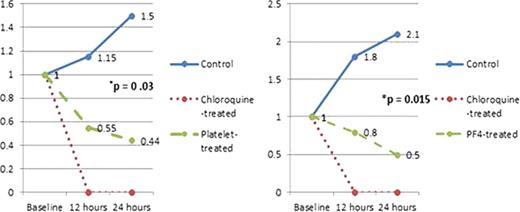Abstract 1140
Malaria is a thrombocytopenic syndrome. Platelet activation occurs after binding to the knobs of Plasmodium-infected erythrocytes (Srivastava et al 2008). Severely thrombocytopenic thrombopoetin receptor knock-out mice infected with murine malaria have significantly higher mortality as compared to wild-type mice (McMorran et al 2008). Platelets have significant antibacterial properties when added to the bacterial cultures (Yeaman et al 2002). These are mediated by platelet microbicidal proteins, or kinocidins, alpha granule proteins related to the chemokine Platelet Factor 4 (PF4). PF4 possesses antibacterial properties itself. Additionally, plasma PF4 levels are significantly elevated in malaria. We hypothesized that the antimalarial properties of platelets are mediated by PF4-related thrombocidins, and studied growth-inhibition of platelet and PF4 on Plasmodium falciparum, in vitro.
Plasmodium falciparum (ITG-2F2 strain) was cultivated in O negative human erythrocytes in a media comprised of RPMI 1640 plus glutamine, hypoxanthine and human serum, at low O2 (1%) and 37°C (Trager and Jensen 1972). Parasite growth was monitored by estimating percent parasitemia of stained smears by light microscopy. The parasite growth cycle was synchronized using gelatin floatation prior to the experiments. To ensure similar baseline parasitemia same stock culture was split between experimental and control cultures. Exp. 1 Washed human platelets were added to the culture of mature stage P. falciparum at a ratio of 1:1 of platelets to erythrocytes, and growth compared to control cultures at 12 and 24 hours. Platelet activation was studied by measuring supernatant PF4 levels (human PF4-specific ELISA [Hyphen Biomed]), and compared to platelet controls, where washed platelets were added to culture media containing only uninfected erythrocytes. Exp. 2 Recombinant human PF4 was added to P. falciparum cultures at a concentration of 2500 IU/ml, and growth compared to control cultures at 12 and 24 hours. Chloroquine-treated cultures represented positive controls in all experiments. The results of the experiments are reported as proportional change in baseline parasitemia, averaged for repeat experiments.
The results of this study indicate that the platelets are inhibitory to the growth of Plasmodium falciparum, in vitro. This is accompanied by platelet activation as evidenced by significantly higher PF4 levels in the presence of infected erythrocytes. Furthermore, we demonstrate that PF4 is growth-inhibitory to P. falciparum, likely mediating the plasmodicidal action of the platelets. This effect of platelets is dependent on the growth stage of parasites and appears to affect primarily mature stages. Currently available data do not exclude an intra-erythrocytic effect of PF4, but our data support the more likely hypothesis that the cytotoxic effect of PF4 occurs following the release of merozoites from erythrocytes. Although, supra-physiologic platelet and PF4 concentrations were used in this study, platelets are known to rosette Plasmodium-infected erythrocytes in vivo, particularly in microcirculation, indicating that the ‘local’ concentrations of PF4 are likely higher. Therefore, our data provide additional experimental evidence in support of the role of platelets in malaria innate immunity.
No relevant conflicts of interest to declare.


This feature is available to Subscribers Only
Sign In or Create an Account Close Modal